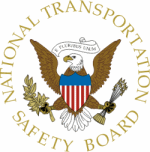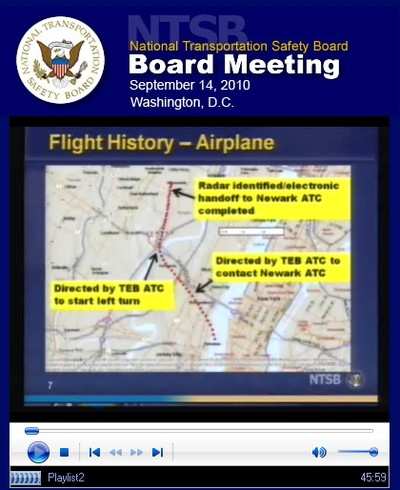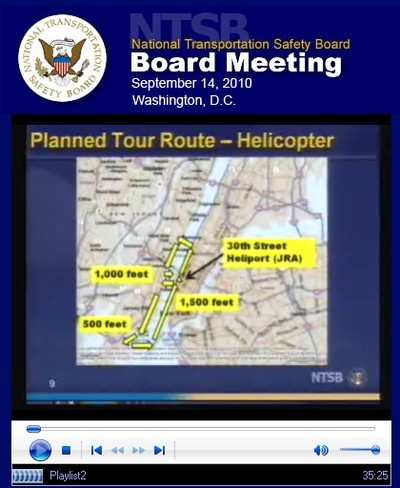Tue, Sep 14, 2010
Pilots, Controller, FAA All Cited As Contributing To The
Accident
 The NTSB took about five hours
Tuesday to come to a determination of probable cause in the
accident last year over the Hudson River that fatally injured
nine people, and sparked major changes in air space rules in the
popular VFR corridor. The ruling could be seen as calling into
question the entire concept of "see and avoid" for maintaining
separation between VFR aircraft.
The NTSB took about five hours
Tuesday to come to a determination of probable cause in the
accident last year over the Hudson River that fatally injured
nine people, and sparked major changes in air space rules in the
popular VFR corridor. The ruling could be seen as calling into
question the entire concept of "see and avoid" for maintaining
separation between VFR aircraft.
During the hearing, which was presented online via streaming
video, witnesses recounted the events that led up to the August
8th, 2009 accident in which a Piper PA-32R-300 (N71MC) with three
people on board collided with a Eurocopter AS 350 BA (N401LH)
carrying five passengers on a sightseeing tour. The helicopter was
determined to be about 100 feet above its planned altitude of 1,000
feet when it collided with the Saratoga. The New York
Times reports that witnesses before the Board said that it was
likely that the Piper pilot could have seen the helicopter, but
that it would have been difficult to discern against the Manhattan
skyline until just a few seconds before the collision. The
approaching Saratoga would have been over the right shoulder of the
Eurocopter pilot, so he would not have been likely to see the
aircraft coming, according to those testifying before the
Board.
Both aircraft were TIS equipped, and a failure of the pilots to
use that traffic avoidance information was cited as a contributing
factor in the accident. The FAA is also named for what the board
called "inadequate" communications procedures and vertical
separation rules in the Hudson River corridor.

But as far as "probable cause" is concerned, the NTSB cited the
"inherent limitations" of 'see and avoid', as well as the actions
of the air traffic controller working the flight from Teterboro.
The controller was reportedly distracted by a personal phone call
while on duty. The Saratoga pilot reportedly read back an incorrect
frequency change instruction on the handoff to Newark Liberty
Airport ATC, which made it so that ATC was unable to contact the
Saratoga to warn that pilot of the impending collision.

The board voted 3-1, with one abstention, that "The NTSB
determines that the probable cause of this accident was the
inherent limitations of the "see and avoid" concept, which made it
difficult for the airplane pilot to see the helicopter until the
final seconds before the collision, and the Teterboro airport local
controllers' non-pertinent telephone conversation which distracted
him from his air traffic control duties including correcting the
airplane pilot's readback of the incorrect frequency, and the
timely transfer of communications for the accident airplane to the
Newark Liberty airport tower. Contributing to the accident were 1)
both pilots ineffective use of available information from the
aircraft's electronic traffic advisory system to maintain awareness
of nearby traffic. 2) Inadequate FAA procedures for transfer of
communication among ATC facilities near the Hudson River Class B
exclusion zone, and 3) FAA regulations that did not provide
adequate vertical separation for aircraft operating in the Hudson
River Class B exclusion zone."
More News
Pilot Also Reported That Due To A Fuel Leak, The Auxiliary Fuel Tanks Were Not Used On June 4, 2025, at 13:41 eastern daylight time, a Piper PA-23, N2109P, was substantially damage>[...]
From 2023 (YouTube Edition): Reflections on War’s Collective Lessons and Cyclical Nature The exigencies of war ought be colorblind. Inane social-constructs the likes of racis>[...]
Pilot Reported That He Was Unfamiliar With The Single Seat Amateur-Built Airplane And His Intent Was To Perform High-Speed Taxi Testing Analysis: The pilot reported that he was unf>[...]
From 2023 (YouTube Edition): First Kits to Ship October 2023 Having formerly resurrected the storied shape of the Ryan ST—in effigy, anyway—Montrose, Colorado-based Tim>[...]
Performance-Based Navigation (PBN) [ICAO] Area navigation based on performance requirements for aircraft operating along an ATS route, on an instrument approach procedure or in a d>[...]
 NTSB Prelim: Piper PA-23
NTSB Prelim: Piper PA-23 Classic Aero-TV: One Mans Vietnam
Classic Aero-TV: One Mans Vietnam NTSB Final Report: Capella Aircraft Corp FW1C50
NTSB Final Report: Capella Aircraft Corp FW1C50 Classic Aero-TV: Timber Tiger Touts Curtiss Jenny Replicas
Classic Aero-TV: Timber Tiger Touts Curtiss Jenny Replicas ANN's Daily Aero-Term (07.04.25): Performance-Based Navigation (PBN) [ICAO]
ANN's Daily Aero-Term (07.04.25): Performance-Based Navigation (PBN) [ICAO]





